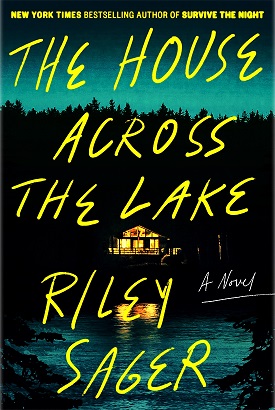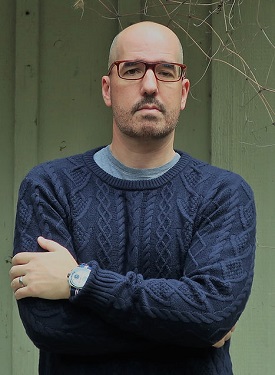 Synopsis:
Synopsis:
Casey Fletcher, a recently widowed actress trying to escape a streak of bad press, has retreated to the peace and quiet of her family’s lake house in Vermont. Armed with a pair of binoculars and several bottles of bourbon, she passes the time watching Tom and Katherine Royce, the glamorous couple living in the house across the lake. Tom is a tech innovator. A former model, Katherine is gorgeous.
One day on the lake, Casey saves Katherine from drowning, and the two strike up a budding friendship. But as they begin getting to know each other — and the longer Casey watches — it becomes clear that Katherine and Tom’s marriage isn’t as perfect and placid as it appears.
Katherine suddenly vanishes, and Casey becomes consumed with finding out what happened to her. In the process, she uncovers eerie, dark truths that turn a tale of voyeurism and suspicion into a story of guilt, obsession, and how looks can be very deceiving.
Review:

Bestselling author Riley Sager firmly believes he is a thriller writer who injects some horror elements into his books. He says that because those are the types of books he is interested in and wants to read, he has never even considered writing any other fiction genre. He began watching the movies of Alfred Hitchcock movies at an early, very impressionable age and loves the artful way Hitchcock blended suspense, secrets, and character studies.
Inspiration for The House Across the Lake struck in October 2020 when Sager spent a week in a Vermont lake house to which he escaped following the pandemic lockdown. “The first night there, I poured myself a bourbon, sat on the back porch that overlooked the water, and stared at the lights of the houses on the other side of the lake,” he recalls. “It got me thinking about who lived there, what their lives were like, and, since I write about such things, what dark secrets they were hiding.” Although Sager was supposed to be on vacation, he found his thoughts returning to the story and plotting the book. So he ended up spending a good portion of the week on the porch, watching the lake, and preparing to draft the book. When he returned home, he wrote it “quickly and surprisingly easily.”
Sager acknowledges that The House Across the Lake “is totally Rear Window on a lake” paying homage to Hitchcock’s classic film. But Sager is committed to not repeating himself in successive books and always contemplates what he can bring to the table that is different. In the case of The House Across the Lake, those portions of the book constitute spoilers, but he promises “there is a lot more going on” in the tale than it initially appears.
From a show business family, Casey Fletcher has enjoyed her own successful career as an actress . . . until recently, when a very public meltdown made her fodder for paparazzi and cost her a role she loved in a Broadway play. At her mother’s insistence, she has retreated to the family’s charming house on the shore of Lake Greene in Vermont, built by her great-grandfather in 1878. Only five houses sit beside the dark waters of the lake and, as the book opens, it is mid-October and Casey is being questioned by Detective Wilma Anson. It seems that Tom Royce, a tech innovator who, along with his wife, Katherine, a former supermodel, owns the house directly across the lake from Casey’s, is missing. He appears to have vanished, leaving his car, keys, and wallet behind, and his house unlocked. Katherine is also missing, and Wilma knows that Casey has been spending time watching the Royce home, as well as its occupants, from her porch. But Casey insists she has no idea where either of them are, and has not observed anything unusual that evening . . . even though she has the prime tied up in her bedroom.
The action immediately shifts to a few days earlier. In Casey’s first-person narrative, she describes her exile to the lake house, and her mother’s daily calls to check in and see if Casey is drinking. She is. A lot. Her days revolve around her rigidly scheduled consumption of bourbon and vodka, ducking her mother’s calls, and thoughts of the career she destroyed, as well as memories of her late husband, Len, a screenwriter, who died in the lake. Casey loved him deeply and they had a happy marriage for several years. Her drinking problem developed after Len’s death. Alcohol is her coping mechanism — it makes it possible for her to avoid confronting and dealing with her emotions. Sager admits that characters like Casey are familiar. “The emotionally damaged woman who drinks too much, spies on her neighbors and sees something she shouldn’t see. . . . It’s evergreen.” But he chose it because he was the “potential to do something new and unexpected with it.”
One evening, despite having had several drinks, Casey is convinced she sees someone struggling in the water, so she clumsily navigates her boat out to the middle of the lake where she discovers Katherine’s motionless body bobbing on the surface. There is no one to help her since Eli, the lake’s only full-time resident, is out for the night. Casey manages to dive into the icy cold water and guide the woman’s body toward the boat, convinced she is dead. But she surprises Casey by regaining consciousness and a budding friendship is born from gratitude, on Katherine’s part, as well as an immediate camaraderie punctuated by crisp, humorous dialogue. Casey is witty, with a sharply self-deprecating sense of humor that Katherine does not understand at first. Casey explains, “I make jokes because it’s easier to pretend I’m not feeling what I’m feeling than to actually feel it.” Casey recognizes that she and Katherine have much in common. “Ridiculously privileged, but self-aware enough to realize it. Yearning to be seen as more than what people project onto us.” But their relationship is short-lived.
Soon, Katherine mysteriously disappears and Casey becomes obsessed with finding her. After all, because the Royce home is a modern glass, steel, and stone structure with massive windows fronting the lake, Casey was able to peer directly inside the Royce home and, using binoculars, observe interactions between Tom and Katherine that Casey found troubling, including one physical altercation. The night before she went missing, Katherine and Tom joined Casey and Eli for drinks, and the tension between them was palpable. The couple is “so at odds that it sucks all energy from the area, making the porch seem stuffy and crowded.” Katherine confides in Casey about the problems in their marriage, revealing that she pays for everything with her substantial earnings from her former modeling career. “Tom needs me too much to agree to a divorce,” she tells Casey half-jokingly. “He’d kill me before letting me leave.” Katherine also confides to Casey that she has not felt well for several days. “I feel weird. Weak.” Exhaustion caused her to collapse while swimming and had Casey not discovered her, she would surely have drowned. The next day, there is no trace of Katherine.
Tom claims that Katherine returned to their New York City apartment, unnerved at the prospective of the forecasted storm passing through the area, Casey simply does not believe his explanation. Undaunted, Casey launches her own investigation, enthusiastically joined by handsome Boone Conrad, who is staying in the house next door while he completes renovations for the owners. Casey finds herself drawn to the former police officer and recovering alcoholic whose wife died under mysterious circumstances. Sager reveals that creating the character was motivated by his own struggle during the pandemic. “Everything was scary and uncertain and we were all stuck at home, so why not drink up?” But after a few months, he recognized that drinking every day could become a problem for him, so he “wanted Boone to be that voice of reason,” he says. “He represents the part of me that realized my actions were close to getting out of hand.” When Casey voices her suspicions, Detective Anson insists that Boone is a sincere voice of reason, and he is honorable and intent on putting his life back together. But could Boone be playing Detective Anson, along with Casey? Sager slyly brings his character and motivations into question, along with those of Tom and Eli, as the story proceeds and Katherine’s whereabouts and fate remain unknown.
Casey is a deeply sympathetic and likable character. She is self-aware: she knows exactly why she is drinking too much and consciously chooses to continue doing so, even as she acknowledges that it does not solve any of her problems or resolve the past she is not yet ready to face. Her concern for Katherine and her well-being is genuine — she is a loyal and supportive friend. As the story proceeds and Casey relates details about the past, explaining how she came to be a drunken voyeur, it becomes clear that she has experienced loss and profound disappointment, including the loss of the husband she loved under tragic circumstances, and has a strong sense of right and wrong. She is stubborn and resilient.
The House Across the Lake is replete with shocking revelations and surprising plot developments that keep the story moving forward at a relentless pace. And yes, Sager eventually demonstrates there is indeed “a lot more going on,” with an inventive, mind-bending, and cohesive twist that readers will not anticipate. He acknowledges that anyone can dream up a plot twist, but the “hard part is making it work in a way that feels organic to the story that’s being told while also playing fair with the reader. The best twists are something you don’t see coming, even though the book has been secretly guiding you to that point the entire time.” Sager seamlessly weaves the surprising twist into the story such that, once revealed, it is apparent that he injected clues throughout the narrative, but readers never saw it coming until he unveiled the truth at an expertly-timed juncture calculated to yield maximum impact. No hints can be revealed, but readers are reminded that Sager is devoted to writing thrillers that contain “some horror elements.” And his observation “that you think you’ve read this story before. Trust me, you haven’t,” is apt.
The House Across the Lake is an engrossing and entertaining thriller, at the center of which is an emotionally complex woman that readers will find themselves cheering on as she searches for her new friend, but the truth eludes her until Sager dramatically unveils a twist that feels completely organic and satisfying. But take Sager’s advice and go “in blind, . . . The less you know, the better.”









Comments are closed.